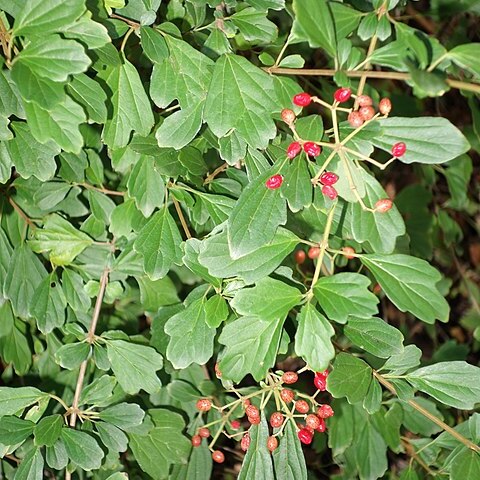Shrubs, deciduous, erect or climbing, to 4 m tall. Bark light brown. Branchlets of current year yellow-brownish stellate-pubescent; branchlets of previous year purple-brown, terete, glabrous, with dispersed, small, rounded lenticels. Winter buds oblong-ovoid, with 2 pairs of separate scales; scales ovate-lanceolate, stellate-pubescent. Leaves always opposite, not clustered at apices of branchlets; stipules often absent; petiole reddish purple, robust, 5-10 mm, stellate-pubescent; leaf blade brownish green when young, ovate or elliptic to oblong-rhombic or obovate, 4-10 × 1.5-2.5 cm, papery to thickly papery, abaxially stellate-pubescent on midvein and lateral veins, rarely densely stellate-tomentose, adaxially densely pubescent on midvein but glabrous elsewhere, midvein raised abaxially, lateral veins 2-4-jugate, lowest pair often elongating to upper part of blade, thus appearing triplinerved, pinnate, arched, branched, ending in teeth, conspicuously raised abaxially, slightly impressed adaxially, veinlets transverse, conspicuously raised abaxially, slightly impressed adaxially, not lobed or sometimes almost 3-lobed, base cuneate to rounded, with 0 or 1 circular gland on both sides of midvein near base, margin subentire or large dentate, apex acute to shortly acuminate. Flowers appearing after leaves; inflorescence a compound umbel-like cyme, at apices of lateral branchlets, 5-8 cm in diam.; rays whorled; first node of inflorescence with 4-8 rays, dense, stellate-pubescent and with red-brown glandular dots, without large sterile radiant flowers; peduncles (0.5-)2-5 cm; bracts and bracteoles late deciduous or persistent, leaflike, green, linear-lanceolate, sparsely hairy. Flowers usually on rays of 2nd order, not fragrant, shortly pedicellate or sessile. Calyx green; tube tubular, ca. 1.5 mm, stellate-pubescent; lobes ovate-triangular, very short, ca. 0.3 mm, stellate-pubescent, apex acute. Corolla white, rotate, ca. 5 mm in diam., sparsely pubescent; tube 2-2.5 mm; lobes spreading, orbicular-ovate, ca. 1.5 mm, exceeding tube, apex rounded, margin very minutely glandular ciliate. Stamens equaling or slightly exceeding corolla, inserted at base of corolla; filaments ca. 3 mm; anthers yellow-whitish, elliptic, less than 1 mm. Styles exceeding calyx lobes; stigmas capitate. Fruit maturing red, ovoid-ellipsoid, compressed, 6-8 × 4-5 mm, base rounded, apex rounded, glabrous; pyrenes compressed, ellipsoid, ca. 6 × 4 mm, with 2 shallow dorsal grooves, and 3 shallow ventral grooves, apex rounded. Fl. May-Aug, fr. Aug-Oct. 2n = 16.
More
A shrub. It grows 3 m high. The leaves are 2-7 cm long by 1-3 cm wide. They have coarse teeth. They are densely hairy especially on the veins and stalks. They flowers are in clusters 2-4 cm wide. There are large leaf like bracts at the base. The fruit is 6 mm across. There is a hard stone with 3 grooves on one side and 2 on the other.

